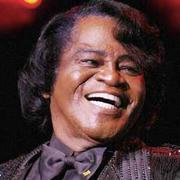James Brown
Other singers were more popular, others were equally skilled, but few other African-American musicians were so influential over the course of popular music. And no other musician, pop or otherwise, put on a more exciting, exhilarating stage show: Brown's performances were marvels of athletic stamina and split-second timing. Through the gospel-impassioned fury of his vocals and the complex polyrhythms of his beats, Brown was a crucial midwife in not just one, but two revolutions in black American music. He was one of the figures most responsible for turning R&B into soul and he was, most would agree, the figure most responsible for turning soul music into the funk of the late '60s and early '70s. After the mid-'70s, he did little more than tread water artistically; his financial and drug problems eventually got him a controversial prison sentence. Yet in a sense, his music is now more influential than ever, as his voice and rhythms have been sampled on innumerable hip-hop recordings, and critics have belatedly hailed his innovations as among the most important in all of rock or soul. Brown's rags-to-riches-to-rags story has heroic and tragic dimensions of mythic resonance. Born into poverty in the South, he ran afoul of the law by the late '40s on an armed robbery conviction. With the help of singer Bobby Byrd's family, Brown gained parole and started a gospel group with Byrd, changing their focus to R&B as the rock revolution gained steam. The Flames, as the Georgian group was known in the mid-'50s, signed to Federal/King and had a huge R&B hit right off the bat with the wrenching, churchy ballad "Please, Please, Please." By that point, the Flames had become James Brown & the Famous Flames; the charisma, energy, and talent of Brown made him the natural star attraction. All of Brown's singles over the next two years flopped, as he sought to establish his own style, recording material that was obviously derivative of heroes like Roy Brown, Hank Ballard, Little Richard, and Ray Charles. In retrospect, it can be seen that Brown was in the same position as dozens of other R&B one-shot: talented singers in need of better songs, or not fully on the road to a truly original sound. What made Brown succeed where hundreds of others failed was his superhuman determination, working the chitlin circuit to death, sharpening his band, and keeping an eye on new trends. He was on the verge of being dropped from King in late 1958 when his perseverance finally paid off, as "Try Me" became a number one R&B (and small pop) hit, and several follow-ups established him as a regular visitor to the R&B charts. Brown's style of R&B got harder as the '60s began; he added more complex, Latin- and jazz-influenced rhythms on hits like "Good Good Lovin'," "I'll Go Crazy," "Think," and "Night Train," alternating these with torturous ballads that featured some of the most frayed screaming to be heard outside of the church. Black audiences already knew that Brown had the most exciting live act around, but he truly started to become a phenomenon with the release of Live at the Apollo in 1963. Capturing a James Brown concert in all its whirling-dervish energy and calculated spontaneity, the album reached number two on the album charts, an unprecedented feat for a hardcore R&B LP. Live at the Apollo was recorded and released against the wishes of the King label. It was this kind of artistic standoff that led Brown to seek better opportunities elsewhere. In 1964, he ignored his King contract to record "Out of Sight" for Smash, igniting a lengthy legal battle that prevented him from issuing vocal recordings for about a year. When he finally resumed recording for King in 1965, he had a new contract that granted him far more artistic control over his releases. Brown's new era had truly begun, however, with "Out of Sight," which topped the R&B charts and made the pop Top 40. For some time, Brown had been moving toward more elemental lyrics that threw in as many chants and screams as they did words, and more intricate beats and horn charts that took some of their cues from the ensemble work of jazz outfits. "Out of Sight" wasn't called funk when it came out, but it had most of the essential ingredients. These were amplified and perfected on 1965's "Papa's Got a Brand New Bag," a monster that finally broke Brown to the white audience, reaching the Top Ten. The even more adventurous follow-up, "I Got You (I Feel Good)," did even better, making number three. These hits kicked off Brown's period of greatest commercial success and public visibility. From 1965 to the end of the decade, he was rarely off the R&B charts, often on the pop listings, and all over the concert circuit and national television, even meeting with Vice President Hubert Humphrey and other important politicians as a representative of the black community. His music became even bolder and funkier, as melody was dispensed with almost altogether in favor of chunky rhythms and magnetic interplay between his vocals, horns, drums, and scratching electric guitar (heard to best advantage on hits like "Cold Sweat," "I Got the Feelin'," and "There Was a Time"). The lyrics were not so much words as chanted, stream-of-consciousness slogans, often aligning themselves with black pride as well as good old-fashioned (or new-fashioned) sex. Much of the credit for the sound he devised belonged to (and has now been belatedly attributed to) his top-notch supporting musicians such as saxophonists Maceo Parker, St. Clair Pinckney, and Pee Wee Ellis; guitarist Jimmy Nolen; backup singer and longtime loyal associate Bobby Byrd; and drummer Clyde Stubblefield. Brown was both a brilliant bandleader and a stern taskmaster, the latter leading his band to walk out on him in late 1969. Amazingly, he turned the crisis to his advantage by recruiting a young Cincinnati outfit called the Pacemakers featuring guitarist Catfish Collins and bassist Bootsy Collins. Although they only stayed with him for about a year, they were crucial to Brown's evolution into even harder funk, emphasizing the rhythm and the bottom even more. The Collins brothers, for their part, put their apprenticeship to good use, helping define '70s funk as members of the Parliament-Funkadelic axis. In the early '70s, many of the most important members of Brown's late-'60s band returned to the fold, to be billed as the J.B.'s (they also made records on their own). Brown continued to score heavily on the R&B charts throughout the first half of the '70s, the music becoming more and more elemental and beat-driven. At the same time, he was retreating from the white audience he had cultivated during the mid- to late '60s; records like "Make It Funky," "Hot Pants," "Get on the Good Foot," and "The Payback" were huge soul sellers, but only modest pop ones. Critics charged, with some justification, that the Godfather was starting to repeat and recycle himself too many times. It must be remembered, though, that these songs were made for the singles radio jukebox market and not meant to be played one after the other on CD compilations (as they are today). By the mid-'70s, Brown was beginning to burn out artistically. He seemed shorn of new ideas, was being out-gunned on the charts by disco, and was running into problems with the IRS and his financial empire. There were sporadic hits, and he could always count on enthusiastic live audiences, but by the '80s, he didn't have a label. With the explosion of rap, however, which frequently sampled vintage J.B.'s records, Brown became hipper than ever. He collaborated with Afrika Bambaataa on the critical smash single "Unity" and reentered the Top Ten in 1986 with "Living in America." Rock critics, who had always ranked Brown considerably below Otis Redding and Aretha Franklin in the soul canon, began to reevaluate his output, particularly the material from his funk years, sometimes anointing him not just "Soul Brother Number One," but the most important black musician of the rock era. In 1988, Brown's personal life came crashing down in a well-publicized incident in which he was accused by his wife of assault and battery. After a year skirting hazy legal and personal troubles, he led the police on an interstate car chase after allegedly threatening people with a handgun. The episode ended in a six-year prison sentence that many felt was excessive; he was paroled after serving two years. Throughout the '90s Brown continued to perform and release new material like Love Over-Due (1991), Universal James (1992), and I'm Back (1998). While none of these recordings could be considered as important as his earlier work and did little to increase his popularity, his classic catalog became more popular in the American mainstream during this time than it had been since the '70s, and not just among young rappers and samplers. One of the main reasons for this was a proper presentation of his recorded legacy. For a long time, his cumbersome, byzantine discography was mostly out of print, with pieces available only on skimpy greatest-hits collections. A series of exceptionally well-packaged reissues on PolyGram changed that situation; the Star Time box set is the best overview, with other superb compilations devoted to specific phases of his lengthy career, from '50s R&B to '70s funk. In 2004, Brown was diagnosed with prostate cancer but successfully fought the disease. By 2006, it was in remission and Brown, then 73, began a global tour dubbed the Seven Decades of Funk World Tour. Late in the year while at a routine dentist appointment, the singer was diagnosed with pneumonia. He was admitted to the hospital for treatment but died of heart failure a few days later, in the early morning hours of Christmas Day. A public viewing was held at Apollo Theater in Harlem, followed by a private ceremony in his hometown of Augusta, GA.


 I Got You (1964 Smash Version) - James Brown
I Got You (1964 Smash Version) - James Brown




























![[STATION] aespa《Dreams Come True》MV Teaser - aespa (에스파)](https://img2.kuwo.cn/wmvpic/324/79/54/2120387380.jpg?imageView2/1/w/195/h/130/format/jpg/q/60)





